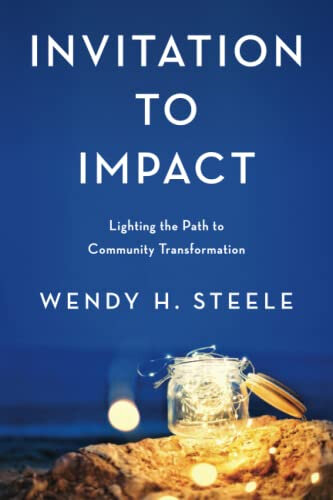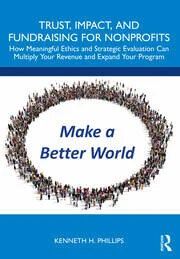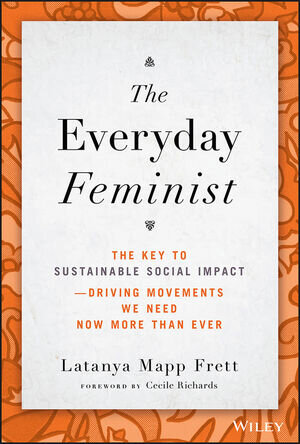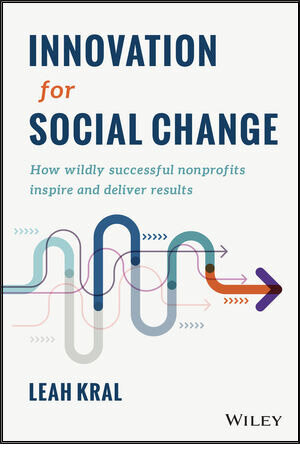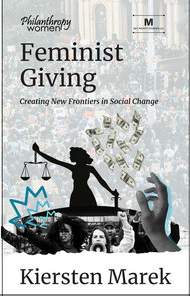Invitation to Impact: Lighting the Path to Community Transformation
“Not I, but We.” This was the motto of the Catholic high school attended by Wendy H. Steele, who would later go on to found Impact100 with the goal of empowering women through collective philanthropy.
In Invitation to Impact: Lighting the Path to Community Transformation, Steele first recounts her own journey and then analyzes the steps she took to create the Impact100 model, grow it, stabilize it, and nurture a new generation of leaders to help maintain it as it expanded beyond the scope of what one woman could hope to manage on her own.
The lessons that led to her founding Impact100 were instilled in her early on, and she dedicates most of the first half of the book to her personal life as the middle of three sisters. Perhaps the first time Steele had responsibility thrust upon her was when her mother unexpectedly died just as she was about to enter high school—in what she was told was an unfortunate accident, only to learn later was a suicide.
It was in high school, though, while reeling from this tragedy, that she was introduced to that phrase that would go on to guide so much of her work: “Not I, but We.” This new understanding of the power of collectives and having overcome the trauma of her mother’s death at such a young age planted a seed that Steele would develop into the gold standard for collective giving.
Back in the ’80s, when Steele graduated from college, personal banking was still a relatively new field, but she saw it as a way to work directly with people to make their dreams come true. “I came to see banking as a way to help people achieve more than they ever could on their own,” she writes. “A loan might enable a customer to start or grow a business. Mortgage loans allowed home-ownership or education.” Working in banking taught Steele not only the rewards of supporting those who were less fortunate but also the transformative power of large sums of money.
The last push that drove Steele to Impact100 was motherhood. In the space of five years, Steele became the mother of three children and also moved from Connecticut to Cincinnati. To adapt to these changes, Steele had to adjust her work-life balance, and she spent time working remotely, working part-time, and being a stay-at-home mom to make it work. Her career, while important, was no longer her most important achievement, and as her priorities shifted, she began to think of other ways to define success.
Around this time, Steele heard a story about a church in need of financial assistance. According to Steele, while the head of the church’s men’s group figured out how much he could give based on his household budget and then asked the others in the group to do the same, doing either never even entered the mind of the leader of the women’s group.
Steele was inspired to create a giving vehicle exclusive to women—to help them exercise their new financial independence in a way that also benefited others.
That story made Steele realize something of vital importance: When women give philanthropically—if they do at all—they do so in very different ways than men. It was only in 1974 that the Equal Credit Opportunity Act gave women the right to their own credit cards, separate from their husbands, and Steele was inspired to create a giving vehicle exclusive to women—to help them exercise their new financial independence in a way that also benefited others. To facilitate this kind of giving, she would need to develop a completely new model. She sat down with a spiral notebook and got to work, beginning with a list of the reasons other women had given her for why they weren’t already donating to charitable causes. What she found overwhelmingly was that women didn’t feel like they had enough: not enough time, not enough energy, and not enough money. Steele realized that asking many women to give a little bit of each these would create impact greater than the sum of its parts. And, more importantly, such a giving model would be accessible to the women she wished to target.
Steele was ready to start implementing Impact100 in 2001, when she had to put her plans on hold as a result of 9/11. When she and the other women she gathered to help start the project were finally able to launch it in March 2002, however, they hit the ground running. The key was determining the amount of money they would ask of every woman that would allow for a critical mass of participants while still being significant enough to create real collective impact. She landed on $1,000 and held firm. Steele was also deeply invested in making sure that 100 percent of every dollar Impact100 spent went to the grantees. And with regard to grantees, she laid down two ground rules to guide the organization’s giving: Grantee projects needed to be both impactful and sustainable.
But the key to Impact100’s success didn’t lie only in its very smart and simple concept; Steele also did extensive work to publicize the organization. She landed an interview with People magazine that made Impact100 a household name and launched a wave of additional news coverage.
Being open about Impact100’s process has not only drawn more members to it but also created a pipeline of leadership to fill the gaps that Steele, as one woman, cannot. She also invested in research to support the organization’s principles and guide its strategy, with results she still learns from.
Impact100 saw significant growth within just a few years to become one of the most well-known philanthropic organizations, not only in the United States but across the globe, with 60+ chapters of at least 100 women making grants collectively of at least $100,000 to local organizations. Steele spends much of the rest of the book explaining how she managed this growth and expansion to cultivate the reputation Impact100 enjoys today. One particular area of note here is her insistence on full transparency. Being open about Impact100’s process has not only drawn more members to it but also created a pipeline of leadership to fill the gaps that Steele, as one woman, cannot. She also invested in research to support the organization’s principles and guide its strategy, with results she still learns from. She focused on what draws women to Impact100 and what earns their trust; she learned that Impact100 members feel in control of their giving through the organization and understand their individual role therein. Impact100 has improved the confidence of a vast majority of its members (93 percent) and increased the knowledge of nearly all (98 percent). Impact100’s model has also had a ripple effect on collective philanthropy more broadly, inspiring a new wave of giving by its members not only through the organization but also outside of it.
If I were to point out any issues with the book, it would be that, especially for a book as short as it is, it seems to want to be two things—both a memoir and a how-to book on starting a giving circle, making it relevant (particularly to populations who aren’t known for their participation in philanthropy), and growing it for maximum impact. The issue is that, while it is easy to see how her personal circumstances led her to create Impact100, many of them aren’t relevant to its implementation or success, nor are they replicable for others seeking to do the same. Particularly in the second half, there are points where Steele interrupts her discussion of Impact100 with anecdotes from her personal life, miring the reader in unnecessary details and distracting them from the most useful information in the book.
But that’s a quibble. The real worth of Invitation to Impact is the insight from the founder of an organization that has galvanized a population that has been historically underrepresented in philanthropy, to remarkable results—and that alone is invaluable.
Audrey Silverman is a fundraising professional working in the Jewish nonprofit sector.


